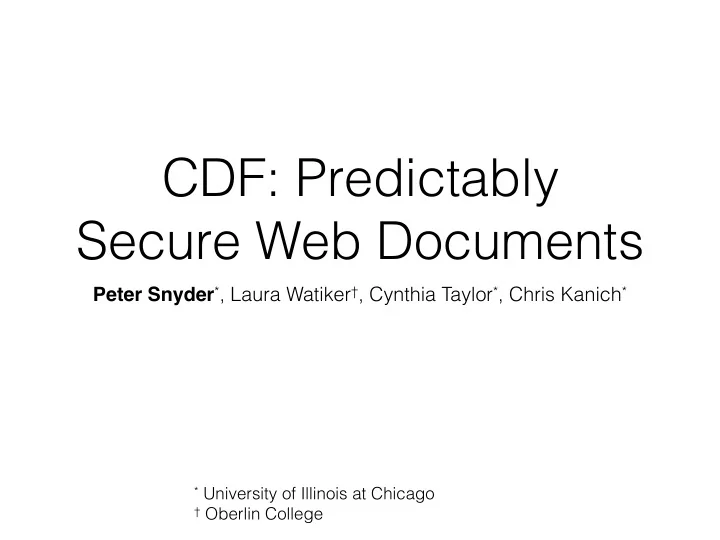

CDF: Predictably Secure Web Documents Peter Snyder * , Laura Watiker † , Cynthia Taylor * , Chris Kanich * * University of Illinois at Chicago † Oberlin College
Overview • The web is great! But complex! • Complexity makes reasoning about privacy and security difficult for consumers • Consider giving advice to non technical users • Knowing what we know now : Is there a way to improve web security and privacy, without preventing authors from creating the types of sites users want?
The Web Today • Interactivity is delivered as (mostly) unrestricted JavaScript • Difficult to know code will be benign and “useful” : - form validation - improve user experience - drive user-serving widgets and page elements • Or malicious : - fingerprint the user - exploit a vulnerability - from untrusted source (XSS)
Complexity vs. Benefit Web API Standard # Sites Uses % Blocked Gamepad 3 0.0% Performance Timeline, Lv. 2 1,728 93.7% WebRTC 1.0 28 29.2% XMLHttpRequest 7,957 13.9%
Complexity vs. Benefit CSS − OM DOM H − WB 10,000 H − C WCR DOM2 − H NS DOM1 H − CM HRT DOM2 − T DOM4 HTML SLC HTML5 PT AJAX DOM2 − E UTL TC BA BE CSS − VM FA DOM − PS DOM2 − C SEL CSS − FO PT2 DOM2 − S SVG EC UIE H − HI 1,000 MSE DOM3 − C WEBGL H − WW Sites using this standard DOM3 − X RT H − WS FULL CSS − CR IDB GEO WEBA H − P 100 F NT MCS SO ALS WRTC PL WN PE EME 10 # GP URL E V HTML51 CO DO MSR DU MCD SD SW GIM H − B TPE WEBVTT PV 0% 25% 50% 75% 100% % of Usage blocked by Ghostery and Adblock
Goals Keep Gain • HTTP(S) • Predictability • Decentralized / Rapid • Security Deployment • Privacy • Interactivity • Removing arbitrary • Styling / Presentation code execution • Web Browsers
Approach: Contained Document Format 1. Document Format : • JSON format, simple to check • Structure (like HTML) • Declarations of interactivity (vs. implementation) 2. Client Proxy : Translates CDF -> HTML+JS 3. Trusted Libraries : Implement safe interactivity
CDF Documents • Structure: • Comparable to HTML tags • Forces separation of structure and text • Events: • Designate when something should happen • Taken from common DOM and framework provided events • Behaviors: • Designate what happens when an event triggers • Static definition, safely converted into JavaScript by TCB • Selected from common web idioms (element manipulation, timers, tabs, network communication, etc)
Parser Example
CDF Flow Browser Proxy Server 1. Client Request 2. CDF File 3. CDF → HTML+JS 4. HTML+JS 5. Trusted JS 6. “Safe” Assets
Advantages • Limited Trusted Base No plugins, restricted Web API use • Client Side Fingerprinting No JS means no JS based approaches (font / plugin enumeration, canvas fingerprinting, etc.) • Predictable Information Flow No iframes, no HTTP referrers, restrictions on forms, “tracking speed bump" • Page Defacement / XSS Typing in CDF documents, no script injection
Usability Tests • Popular blog: http://www.vogue.com/ • Online-banking: https://www.bankofamerica.com/ • Social media: https://twitter.com/ • Collaborative web application: HotCRP
Conclusion • Modern web provides web authors great flexibility • This flexibility makes it difficult for consumers to reason about security and privacy online • With (relatively) small changes, the web could provide more predictable privacy and security, without sacrificing expressivity. • CDF is a design experiment to explore different privacy / capability tradeoffs. • Source: https://github.com/bitslab/cdf • Thank you!
Recommend
More recommend